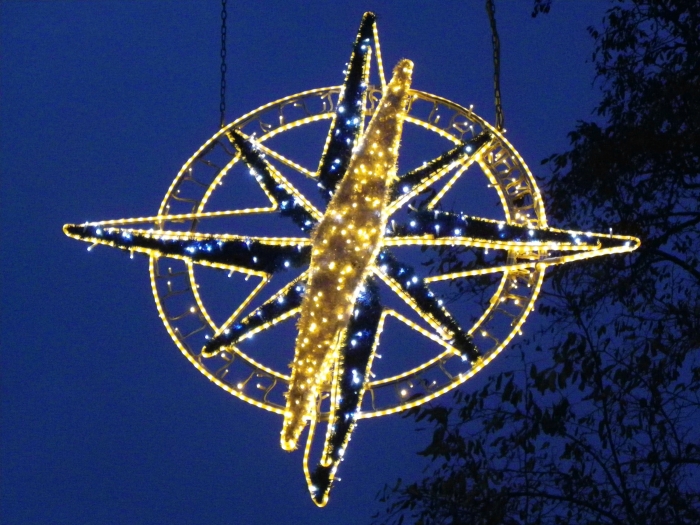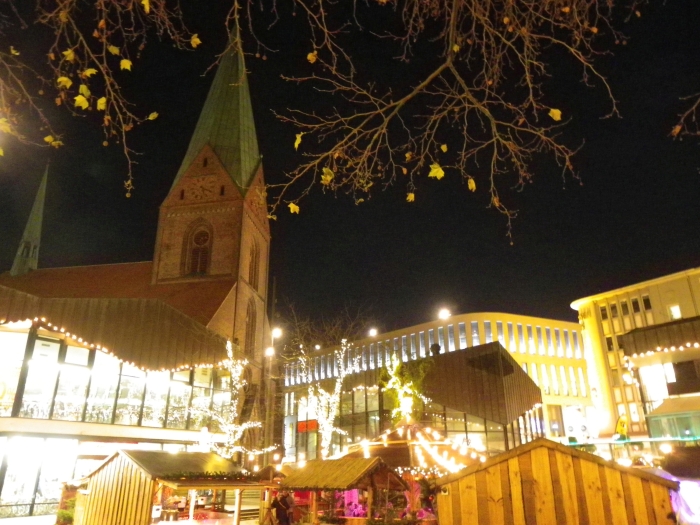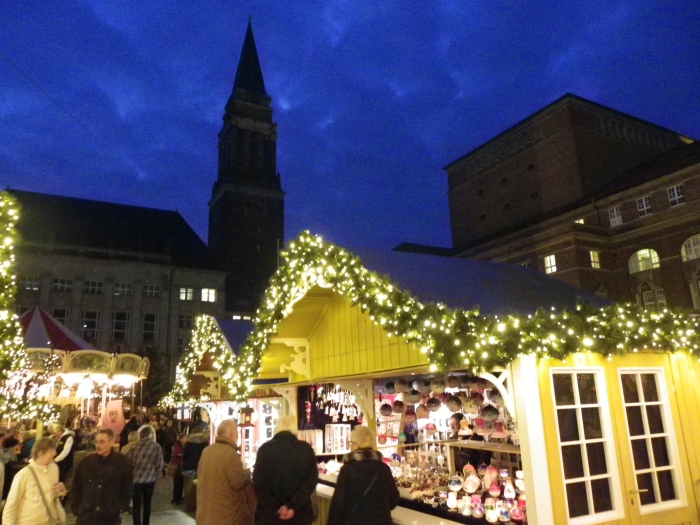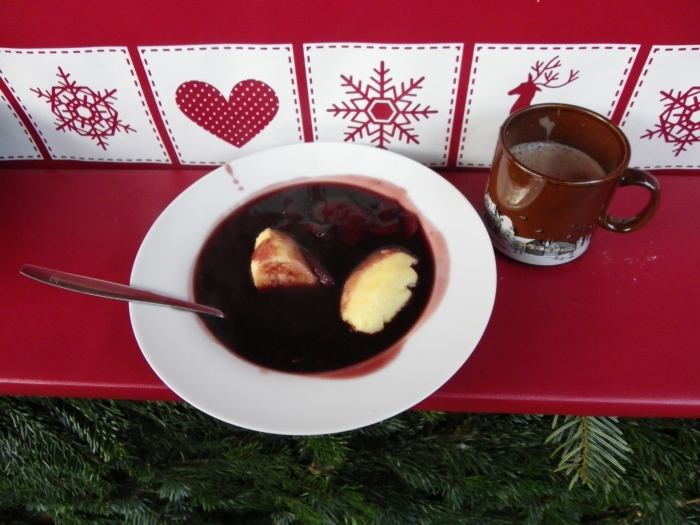
Moin, Moin, Ihr Lieben! Our first Christmas market on a quite adventuresome tour of 2016 takes us far north to Schleswig-Holstein and the city of Kiel. Located along the Baltic Sea coast, the city of 245,000 inhabitants is the largest of the big three ports located on a fjorde, providing shipping from places in the north and east. The other two are Lübeck and Flensburg. Kiel is the state’s capital and has its state parliamentary building located on the western side of the coast. Apart from two universities, the city prides itself on its traditional handball team THW Kiel, whose stadium is directly in the city center. It also has the annual convention of sailboats, clipper ships and yachts in June- the Kieler Woche, where over 100 countries take part in competition and display their best ships. And while parts of Kiel, especially in the city center, appear quite crowded, there are two bright spots that make the city quite convenient and attractive: everything is centralized- especially the city center, and there are some great natural spots along the Baltic Sea and the Grand Canal (Baltic-North Sea Canal (Ger.: Nord-Ostsee Kanal)), as well as along the Schwentine River, which empties into the fjord near the University of Applied Sciences (Fachhochschule).
Maybe that Kiel Defense as practiced in a game of chess inspired the architects and city planners to be creative with their city designs…… 😉
As for the Christmas market, it is a whole different story. The Christmas market is located only 300 meters north of Kiel’s Railway Station, beginning at Holstenplatz, but the market is spread out into three different places, all connected with a main shopping corridor known as the Holstenstrasse. A map at the end of this article shows you where the places are, starting with the train station and working the way up north.

Looking at the markets themselves, we’ll start off with the one on the northernmost end at St. Nicolas Church at the corner of Schlossstrasse and Schumacherstrasse. If one does some ice skating at the Ostseekai ice skating rink near the cruise liner port, the opportunity for a good Glühwein and something warm can be found at this place, as the huts serve as a compliment to the eateries nearby. This includes soups, fried fish sandwiches and even a Glühbier (mulled beer) or punch. For churchgoers, it is a great place to talk Luther and his Reformation of the Church while keeping warm. Yet apart from the spectacular view of the church at night, as well as at the Schwedenkai with its light-candied yacht overlooking the man-made pond, it’s all eateries with typical German delicacies-
unless you love beer, like this writer does. 😉
If so, just west of the market, there is the Kieler Brewery and Restaurant, located at Dänischstrasse on the north side of the market. Founded in 1988, the brewery has been producing its beer products including pilsners and those using beachwood directly at its original location. One can only purchase the beer there, which serves as another incentive to visit Kiel (apart from Kieler Woche and the handball games with the Zebras). The restaurant, which serves only local and seasonal specialties, has an interior that resembles a restaurant during the age of Luther: walled with stone with cast iron chandeliers and benches made of wood, making it look like knights, monks, reformers and musicians with bagpipes entering the scene, playing music and enjoying a good brew. I tried one of the originals (beechwood aged) and am pleased to say, the product aced the test because of its taste and thickness of the body. A solid 1,0 (A+) 😀

Moving further south along Holstenstrasse, laden with shopping centers and some huts, one needs to turn right at Fleethörn and Hafenstrasse and walk past two streets to find the Kieler Weihnachtsdorf, located at Rathausplatz near the city hall. Flanked by the city hall to the south and the Opera House to the west, the market is rather traditional of German Christmas markets with its backdrop and settings. Unlike the uniformity in colors and hut design as one sees at a Christmas market in Bavaria and parts of Saxony and Hesse, this one was quite colorful, both figuratively as well as literally. Huts and stands of various sizes and colors blanket the whole market, decorated with white-lit natural green garland. The lining of lighted natural Christmas trees and other pine needle branches outside the market, combined with a unique entrance to the village, resemble a natural palace, made of wood. Since Kiel has a palace north of the Ostseekai in the old town, the theme of the Christmas market fits perfectly to one of the city’s prized historic landmarks.
As far as products being served at this village is concerned, I was somewhat disappointed that the majority of the products came from the western part of Germany, in particular Bavaria. No matter where a person went in this village, one will see one Bavarian site for every four. There were no stands that represented the other regions in Germany, in particular, Saxony, where most of the wooden products, like Räuchermänner, Pyramids and villages originate. There were a couple stands for Thuringian bratwurst and a couple stands providing products from Schleswig-Holstein, including a couple local eateries, but overall, it seemed to be typically Bayrish- too much Bavarian. From a personal point of view, if you want to have a Christas market in a community, you should try and vary your products from regions, including areas unknown to others, as well as and especially local places. If you focus more on the commercial aspect- streamling certain regions over others, it will be rather monocultural. Having monocultural markets and events loses the appeal from others who can see similar markets and other events in other cities. This was my impression after seeing too much Bavarian at this place. One needs to dig deeper to find diamonds in the rough in terms of local and unusual goods- a very important rule of thumb for visiting a typical Christmas market. If you don’t want to see a Nuremberg Christmas market in a community, look hard for the localities, as they are there. Follow that with unusual places you will never find in a Christmas market elsewhere.

There were a few cool places swimming in a pool of Bavarian goods at the Weihnachtsdorf. They included a liquour stand from North Rhine-Westphalia, a tea shop selling exotic teas some cooked in an “oven,” a lobster stand from the island of Sylt, and a couple stands selling goods handcrafted in and around Kiel (one of which I will mention in a later article). But have you ever heard of Flammlachs?
You have probably heard of pulled pork, as the recipe comes from America but has become very common here in Europe. Flammlachs goes along the same recipe, except you place your salmon or other fish on an oak board, and after adding the ingredients mentioned in the link above, put it as close to the fire as possible without burning the meat to be eaten. Then strip the meat, just like with pulled pork, leaving the fish bones behind, put them in a bun with lettuce and a twist of lemon and serve. While there is sweet mustard and other sauces available, I took the advice of a local and ate it without it. All I can say is “Yummy!” 😀 Your trip to the Baltic Sea coast is not complete without trying a Flammlachs with a good local beer. Enough said!

But as I made my trip to my last stop on the Kiel Christmas market tour, namely Holstenplatz, I found a few other local delicacies from Kiel and Schleswig-Holstein that are not only highly recommended, but in one case, very addicting. The market at Holstenplatz is the longest market I had visited up until now, but also the most diverse of Kiel’s Christmas markets. A mixture of local products combined with handcrafted and international products from Estonia, Turkey and France can be found along three rows of huts that feature a various form of brown wood colors from mahogany to oak to even a light brown. The huts are far different in color patterns than the colorful display at the Weihnachtsdorf and the striped huts at St. Nick’s church, which makes them completely different, but attractive to the visitors. The market here is also decorated nicely with natural garland that is also lighted. Despite not having a Christmas tree, the trees lining along Holstenplatz are also lit at night, thus making the market not only colorful, but somewhat homey. 🙂

Despite its very close proximity to the shopping areas and the main highway- Sophienblatt and Andreas Gayk Strasse- the market appears to be rather spacious, thus allowing for space to walk around and find a place to enjoy the specialties offered. The problem with space was one of the problems I’ve seen with many Christmas markets I’ve visited since starting the series in 2011, as many markets try to reduce “excessive” space by adding more stands and booths than necessary and in some cases, herding the people in and out of the markets like a person is in rush-hour traffic in a big city. This makes visiting a Christmas market more of a torture than fun. With the markets Kiel, space doesn’t seem to be the issue as there is enough. Given the proximity of the markets, this means that there is not so much crowding, especially on weeknights and weekends, which given the few people at the market, it was really comfortable to have a conversation with locals about goods worth tasting……

……including this entrée, the Fliederbeersuppe (freely translated as currant soup). 🙂 Consisting of currant juice (highly concentrated), apple slices and Grießklöße (semolina dumpling), this soup is typical of Schleswig-Holstein and one that a person must try. I was skeptical when I first saw it and the response of the person selling this was a classic: “Are you diabetic?” My response was: “I’ve never tried it before, which is why I wanted to know more about it.” I later told her I was a columnist for the Files and talked about the series on German Christmas markets. I tried the soup in exchange for money and the address of this site. 😉 And there was no regret that it tasted really good. So good that it is sometimes addicting. A lady stopping at the stand as I was eating it with a hot cup of Lumumba (hot cocoa with rum) testified its addiction as she was going for her seventh bowl! Seven bowls is a bit over the top, but it shows that one really needs to taste it to believe it. 🙂
Before I got addicted, I left to check out the other goods, which included Kochwurst (cooked sausage) from a local butcher, and local pastry featuring filled donuts and Muzen, a boiling pastry with powdered sugar and also typical of the region. Unlike the donuts, which had apple, marzipan, advocaat, cherry and other fruit filling, this one is not filled and are small. Furthermore they taste best when they are hot- not necessarily from the deep fryer, but sometimes reheating them in the oven at 175°C for about 10 minutes should one decide to take them home to have the family try them, like I did (it was my last stop before moving on). Given the fact that there was another stand serving Flammlachs, the market at Holstenplatz is your best place to try everything that is local and typical of Schleswig-Holstein, for the Weihnachtsdorf have predominantly Bavarian goods and the stands at St. Nick’s are mostly eateries and beverages- a hub for chatting monks and cheery families after having ice skated with Katarina Witt. 😉
Summing up the trip to Kiel, the Christmas market, featuring three different markets connected by the corridor Holsten Strasse is spacious and diverse. It’s an alternative to shopping at the shopping malls, for the huts and other shops provide some goods, eateries and beverages that are both typical of the region but also from other places in Germany and places in Europe. Given its closeness in the city center, they are easily accessible from the train station and the shipping ports, yet surprisingly, the number of people visiting the market is less than others. Given the fact that it was a weekday that I visited, comparing it to other Christmas markets, it is rather comfortable entertaining strangers and friends over a good local specialty. I bet it applies to weekend visits as well. Despite being surrounded by concrete, the market is easy to find because of the close proximity to the places in the city center, thus making it accessible by all means of transportation. In other words, even if the Christmas market is a diamond in the rough, it is easy to find.
And if found, that diamond is a lifetime’s worth; especially if you are a stranger in a strange land. 😉
More photos of the Christmas Market in Kiel:
Tips on other Christmas markets the author has visited and written about can be found here. There, you will have some ideas on which places are highly recommended to visit.
![]()
